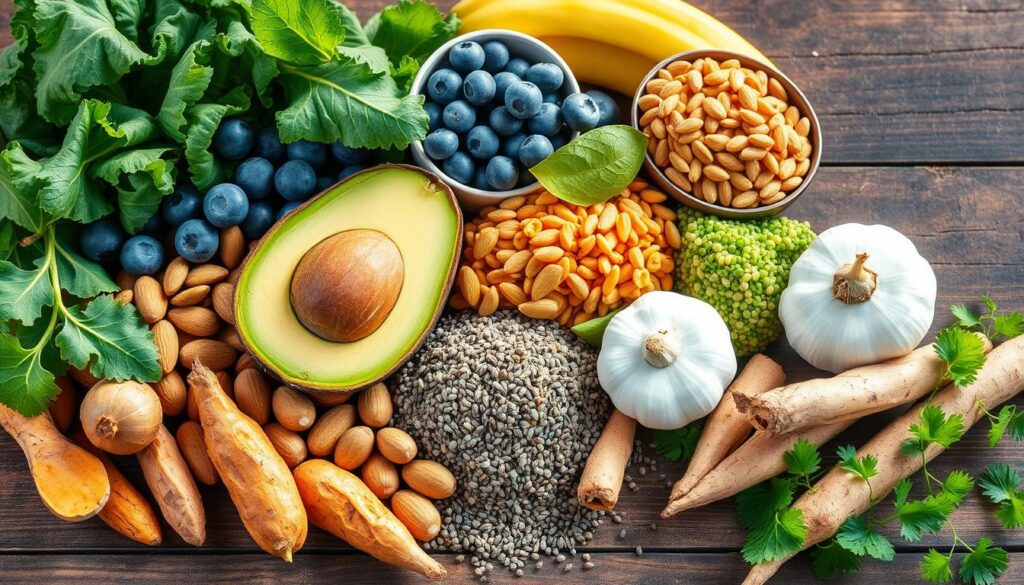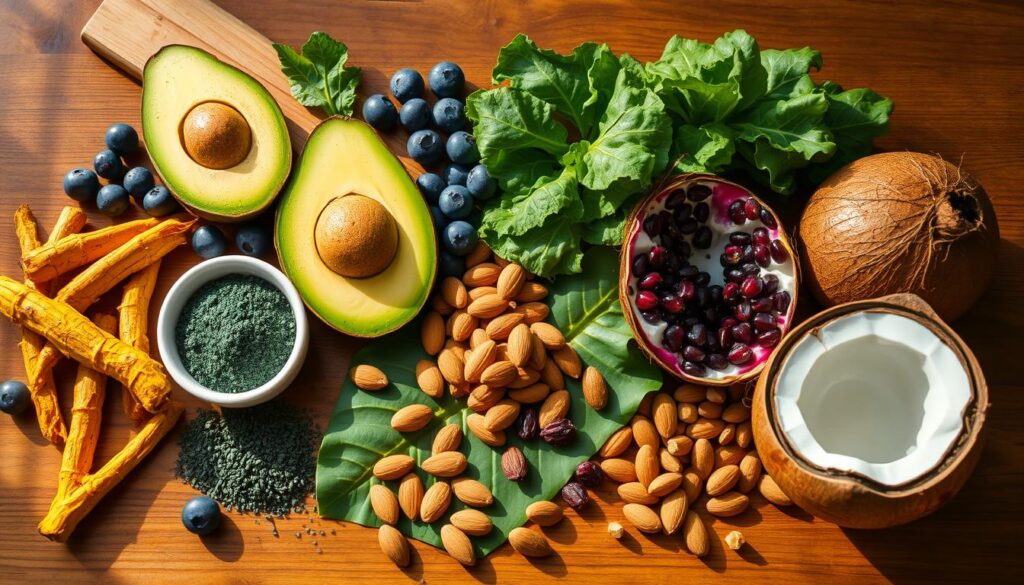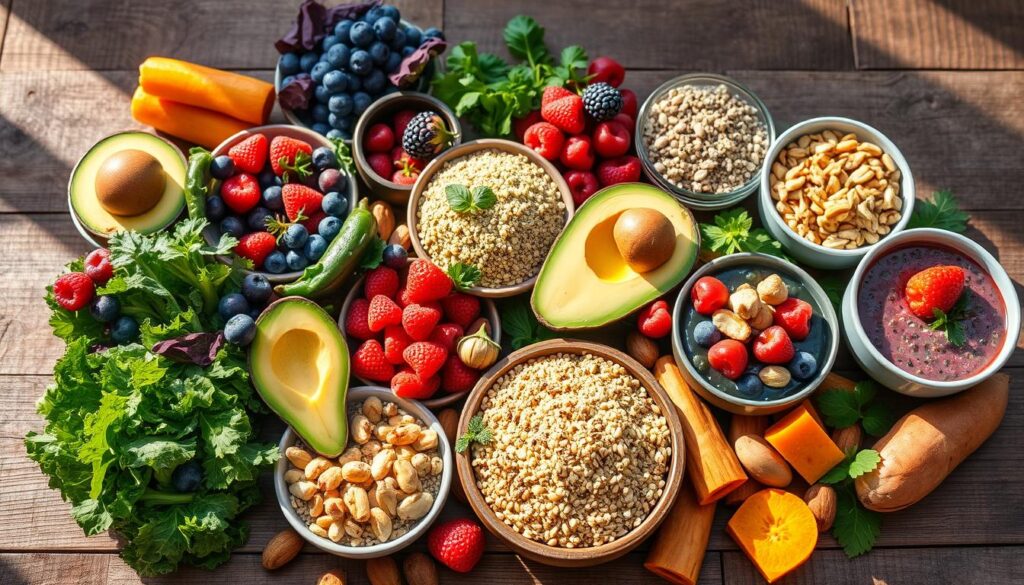Looking for a natural way to boost your health? Superfoods are the answer! These foods are full of nutrients like antioxidants, vitamins, and minerals. They can greatly improve your health. Let’s dive into the top 10 superfoods that can boost your energy and longevity.
So, what makes a food “super”? These foods are known for their high nutrient content and amazing health benefits. From berries to leafy greens, each superfood has its own way to help you stay healthy. Get ready for a tasty journey to a healthier, more vibrant you!
Key Takeaways
- Superfoods are nutrient-dense whole foods with exceptional health benefits
- They are rich in antioxidants, vitamins, minerals, and other beneficial compounds
- Incorporating superfoods into your diet can enhance overall well-being and longevity
- The top 10 superfoods offer a wide range of health-boosting properties
- Exploring the power of superfoods is a natural way to elevate your vitality
Understanding the Power of Natural Superfoods
In the world of nutrition, some foods are true “superfoods.” They are packed with nutrients that help our health and well-being. But what makes a food “super,” and how can we use their power?
What Makes a Food “Super”?
The term “superfood” refers to plant-based foods rich in vitamins, minerals, and phytonutrients. These nutrients, found in organic fruits and veggies, protect cells and fight chronic diseases. They act as antioxidants and anti-inflammatory agents.
The Science Behind Superfood Benefits
Research on superfoods is impressive. Eating these foods can boost our immune system, heart health, brain function, and slow aging. Their mix of vitamins, minerals, fiber, and phytonutrients supports our overall health.
Role in Disease Prevention
Superfoods fight oxidative stress and inflammation, helping prevent chronic diseases. They can lower the risk of heart disease, type 2 diabetes, cancers, and neurodegenerative disorders. Adding organic superfoods to our diet supports our health and well-being.

“Superfoods are not a quick fix or a magic bullet, but rather a long-term investment in your health and well-being. By making them a regular part of your lifestyle, you can reap the benefits of their incredible nutritional power.”
Superfoods: Ancient Wisdom Meets Modern Nutrition
In today’s fast world, we often overlook the ancient secrets to health. For centuries, plant-based and whole foods were valued by ancient civilizations. Now, we’re seeing how organic superfoods blend old wisdom with new science.
The Aztecs prized chia seeds, while the Egyptians loved turmeric. These superfoods have been healing and nourishing for thousands of years. Even as science learns more, their benefits remain unchanged.
“The more we learn, the more we realize that ancient civilizations were truly ahead of their time when it came to understanding the power of whole, plant-based foods.”
By combining old and new, we unlock plant-based superfoods’ full power. Turmeric fights inflammation, and blueberries boost brain health. These foods are more than trends; they’re essential for a healthy life.
So, when you enjoy a superfood smoothie or add chia seeds to your meal, you’re part of a long tradition. It shows that ancient wisdom and modern nutrition are perfect together for wellness.

Blueberries: Nature’s Antioxidant Powerhouse
Blueberries are not just sweet and juicy. They are also a superfood, full of antioxidants, phytonutrients, and vitamins. These small blue fruits are known for their health benefits.
Anti-aging Properties
Blueberries are full of antioxidants. These fight free radicals, which harm cells and speed up aging. Eating blueberries can keep your skin and cells young and healthy.
Brain Health Benefits
Blueberries are good for your brain. They have antioxidants and phytonutrients that boost memory and protect against brain decline. Eating blueberries can improve your focus and mental health.
Best Ways to Incorporate Blueberries
It’s easy to add blueberries to your diet. Here are some tasty ways to enjoy them:
- Add fresh or frozen blueberries to your morning smoothie or yogurt parfait
- Sprinkle them on top of your oatmeal or cereal for a nutritious and satisfying breakfast
- Bake them into muffins, breads, or pies for a tasty and phytonutrient-packed treat
- Snack on a handful of blueberries for a healthy and refreshing pick-me-up
- Use them as a topping for salads, grilled chicken, or fish for an added burst of flavor and nutrition
Make blueberries a part of your healthy lifestyle. Your body and taste buds will love it!
Blueberries are like little gems that pack a powerful punch of health benefits. Incorporating them into your diet is a simple way to boost your overall well-being.
Leafy Greens: The Foundation of Optimal Health
Leafy greens are true superfoods in plant-based nutrition. They are packed with vitamins, minerals, and antioxidants. These nutrients support our overall health. Kale, spinach, collard greens, and arugula each offer unique benefits.
These greens are full of vitamins A, C, and K, and minerals like folate, calcium, and iron. They help keep our immune system strong, support bone health, and aid brain function. They also have lots of fiber, which is good for digestion and blood sugar control.
Leafy greens are also rich in antioxidants. These help fight off harmful free radicals and lower the risk of diseases like cancer and heart disease. Eating more leafy greens may also help prevent cognitive decline and improve mental health.
Adding leafy greens to your diet is easy. Try spinach in your smoothie or mix greens in your salad. You can also sauté or roast them as a side dish or add them to soups and stews. There are many ways to enjoy their health benefits.
Leafy greens are the most nutrient-dense foods on the planet. They’re the foundation of a healthy, plant-based diet.” – Registered Dietitian, Sarah Smith
For the most benefits, try different types of greens. Include kale, spinach, romaine lettuce, Swiss chard, collard greens, arugula, and bok choy in your meals. This way, you get a variety of nutrients and antioxidants.
- Kale
- Spinach
- Romaine lettuce
- Swiss chard
- Collard greens
- Arugula
- Bok choy
By eating a variety of leafy greens, you ensure you get all the nutrients and health benefits they offer. This supports your overall health and well-being.
| Leafy Green | Key Nutrients | Health Benefits |
|---|---|---|
| Kale | Vitamins A, C, and K, calcium, iron | Supports bone health, immune function, and eye health |
| Spinach | Folate, magnesium, potassium | Promotes heart health, brain function, and muscle recovery |
| Romaine Lettuce | Vitamins A and K, fiber | Aids in digestion, supports bone density, and reduces inflammation |
Salmon: Essential Omega-3 Superfood
Salmon is a superfood that’s full of good stuff. It’s a pink fish that’s rich in omega-3 fatty acids. These acids are great for your heart, brain, and help fight inflammation. Whether it’s wild or farm-raised, adding salmon to your meals can make you feel better overall.
Wild vs. Farm-Raised Salmon
The debate is often about wild-caught versus farm-raised salmon. Wild salmon has more omega-3s and less bad stuff like PCBs and mercury. Farm-raised salmon, however, has more anti-inflammatory omega-6s and vitamins like vitamin D. Both can be great for a whole foods-based diet.
Optimal Cooking Methods
- Baking: Preheat your oven to 400°F and roast salmon fillets for 12-15 minutes until flaky.
- Grilling: Fire up the grill and cook salmon steaks or fillets for 6-8 minutes per side.
- Pan-Searing: Heat a bit of olive oil in a skillet and sear salmon for 3-4 minutes per side.
How you cook your salmon matters. Try not to overcook it to keep its natural taste and moisture.
Weekly Consumption Guidelines
Experts say eat salmon or other fatty fish 2-3 times a week. Aim for 4-8 ounces cooked per serving. Mix up your cooking to keep meals fun and tasty.
“Salmon is a true superfood, packed with essential omega-3s that nourish your heart and brain. Enjoy this delicious fish a few times a week for a boost of natural, anti-inflammatory goodness.
Quinoa: Complete Plant-Based Protein Source
Grains have a new rival, and it’s called quinoa. This ancient Andean supergrain is gaining popularity fast. It’s gluten-free and a complete plant-based protein. This makes it great for vegans, vegetarians, and anyone looking for healthy food.
Quinoa stands out because of its rich nutrients. It’s full of essential amino acids, fiber, and vitamins like iron and magnesium. Eating quinoa can boost your immune system, help with digestion, and give you more energy.
“Quinoa is a true superfood – it’s a complete protein, gluten-free, and incredibly versatile. I try to incorporate it into my meals a few times a week.
– Sarah, Registered Dietitian
Quinoa is also very flexible. You can use it in many dishes, from breakfast porridges to salads and pilaf. It’s perfect for making plant-based stir-fries or gluten-free muffins. It’s sure to be a favorite in your kitchen.
Quinoa Preparation Tips
- Rinse quinoa thoroughly before cooking to remove any bitterness
- Use a 1:2 quinoa-to-water ratio for fluffy, perfectly cooked quinoa
- Experiment with different cooking methods, such as simmering, steaming, or even baking
Next time you want to add something healthy to your meals, choose quinoa. It’s a complete package of nutrition. It’s delicious and supports your health and well-being.
Turmeric: The Golden Anti-inflammatory Spice
Discover the power of turmeric, nature’s golden gem! This vibrant spice is a strong fighter against inflammation. It owes its power to curcumin, a compound that has been studied for its anti-inflammatory effects. Turmeric is a top choice for those looking for natural ways to fight chronic inflammation.
Curcumin Benefits
Curcumin is the main active part of turmeric, giving it its golden color and anti-inflammatory strength. Research shows that curcumin can lower inflammation by stopping inflammatory enzymes and molecules. This makes turmeric a great ally against many inflammatory diseases, like arthritis and heart disease.
Absorption Enhancement Tips
- Pair turmeric with black pepper – the piperine in black pepper can significantly enhance the bioavailability of curcumin.
- Consume turmeric with healthy fats like coconut oil or avocado – fat helps the body better absorb the curcumin.
- Try turmeric supplements with added bioperine or phospholipids – these help improve curcumin absorption.
Daily Dosage Recommendations
Experts say to take 400-600 mg of curcumin daily for the best anti-inflammatory effects. This can come from turmeric-rich foods or supplements. But, always talk to your healthcare provider to find the right amount for you.
| Food Source | Curcumin Content |
|---|---|
| 1 tsp ground turmeric | 200 mg curcumin |
| 1 tbsp fresh turmeric root | 400 mg curcumin |
| Turmeric supplement (standardized) | 400-600 mg curcumin |
Enjoy the golden benefits of turmeric and its anti-inflammatory powers. With a few easy tips, you can boost the benefits of this organic, whole foods spice. Make it a key part of your anti-inflammatory health routine.
Chia Seeds: Tiny Seeds with Mighty Benefits
Good things come in small packages, and chia seeds are the perfect example! These tiny seeds are full of nutrients like plant-based omega-3s, fiber, and protein. They also help with digestion and boost energy levels.
Chia seeds are easy to add to your daily meals. Sprinkle them on oatmeal or blend them into smoothies. They’re gluten-free and vegan, making them great for boosting your nutrition. Their mild, nutty taste is also perfect for plant-based baked goods and puddings.
Chia seeds do more than just provide nutrients. They help you stay hydrated by turning into a gel-like texture. This can aid digestion and give you energy all day. Adding chia seeds to your diet is a tasty way to improve your health!
FAQ
What are superfoods and what makes them so special?
Superfoods are foods that are very rich in nutrients. They have lots of vitamins, minerals, and antioxidants. These foods are called “super” because they are very good for your health.
How can superfoods improve my health?
Superfoods have special compounds that help your body in many ways. They can fight inflammation, boost your immune system, and even help prevent diseases. Adding them to your diet can greatly improve your health.
Are superfoods only found in specialty stores?
No, you can find superfoods in regular stores too. Foods like blueberries, leafy greens, and salmon are superfoods. You can find them at your local grocery store or farmer’s market.
How much of these superfoods should I be eating?
The right amount of superfoods varies. It depends on the food and your needs. Aim for 1-2 servings a day. But, it’s best to talk to a dietitian or doctor to find the right amount for you.





